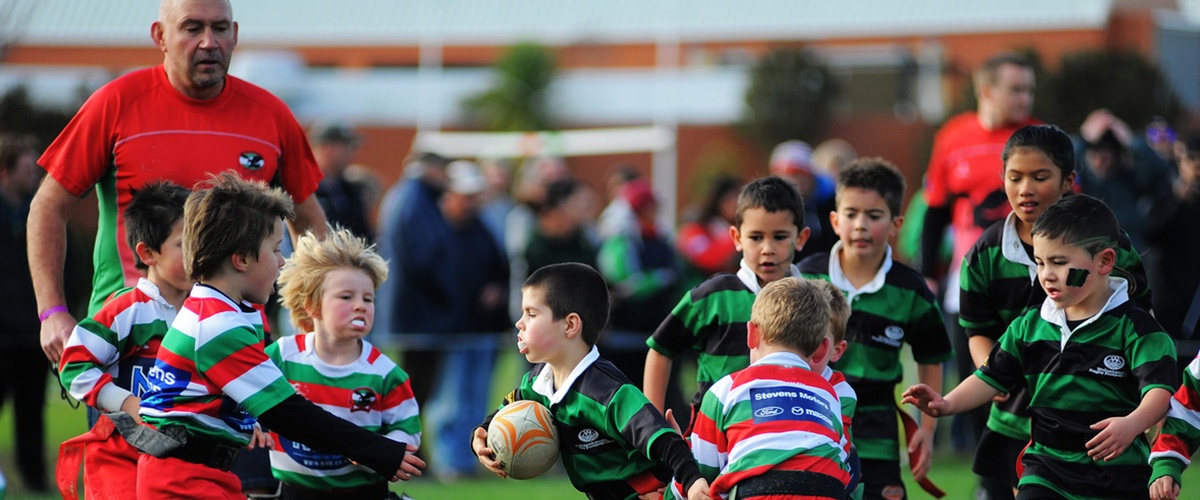- Rugby Toolbox
- The Game
- Rugby Laws
- Beginning Rugby Laws
Beginning Rugby Laws

TOPIC 1: SMALL BLACKS DEVELOPMENT MODEL
The Small Blacks Development Model has been developed to ensure that there is a consistency of play, coaching and player welfare at all levels throughout the country, and is a great way of getting kids involved in team sports.
|
Y1 - U6 | Y2 - U7 | COMMENTS | |
| Numbers on Field | 7 | 7 | These numbers are maximums. If a team doesn’t have enough players to start a game, it should then be played with equal numbers. | |
| Field Size | 1/4 | 1/4 |
¼ field = 40m x 27.5m maximum. |
|
| Try | 5pts | 5pts | If score blow-outs are occurring (ie 35= at halftime), both coaches MUST meet and come to an agreement as to how they can generate a more even contest. | |
| Conversion | - | - | None | |
| Ball Size | 2 1/2 | 2 1/2 | Balls will be colour coded for each size. Size 2 1/2 = orange, Size 3 = blue, Size 4 = green. | |
| Tackles | Rip | Rip | There will be no fending at all. | |
| Subs | 1/4 time | 1/4 time | All players must play a minimum of half a game (this is to include at least two full quarters). Rolling substitutions are not permitted. Substitutions may be made at half time or approximately half way through each half when the referee will allow and signal a Substitution Break. |
|
| Kick-off | Tap & Pass | Tap & Pass | ||
| Penalty | Tap & Pass | Tap& Pass | ||
| Kicking (general play) | No | No | ||
| Length of Game | 2 x 20 | 2 x 20 | These are maximums. | |
| Scrums | No | No | Tap & pass | |
| Lineout | No | No | Tap & pass |
BEGINNING RUGBY LAWS UNDER 6 - UNDER 7
These laws complement laws outlined in the Small Blacks Development Model.
SCORING/RESTART
- A try is scored by grounding the ball on or over the goal line.
- The non-scoring team will restart play with a tap kick from halfway. (Free pass for Rippa rugby)
- The opposing team will be back five metres from halfway.
TACKLE
- A tackle comprises a rip for Rippa Rugby.
- The ball-carrier must pass the ball within three steps of being ripped.
- The referee will penalise the player if they continue to run after a rip.
- NO FENDING, BARGING OR PUSHING PERMITTED.
OFFSIDE
- In general play, players are in an offside position when they are in front of the ball when it was last played by a teammate.
- The referee will encourage the ball-carrier to continue when players rip from an offside position.
PENALTY TAP KICK
- The referee will award a penalty free pass for pushing, fending, taking the ball from the ball-carrier's hands, or continuing to run after a rip.
- The defending team will be five metres back from the infringement mark.
- The ball must be passed for the free pass.
KNOCK-ON, FORWARD PASS
Referees are to apply the advantage law generously to foster a free-flowing game.
APPOINTMENT OF THE REFEREE
- The home team will provide a referee or Beginning Rugby referee to officiate.
- If no referee or Beginning Rugby referee from the home team is available, then a referee or Beginning Rugby referee from the visiting team will officiate.
- It is recommended that one referee will control the entire match.
COACHES ON FIELD
A maximum of two coaches per team will be permitted on the field at any one time.
BEGINNING RUGBY REFEREE
In this grade you are most likely to become the referee, so become familiar with all laws of the game you are playing.
Kick-Off/Scoring
- Start (and restart) the game with a tap-kick (tap-kick = ball on ground, move ball with foot, and then pass). When a try is scored, the non-scoring team restarts with tap-kick.
- The opposition team should stand back 5m from the tap-kick.
- Scoring is 5 points for a try.
Tackle
- The tackler places both hands on the opposition player at waist height or below.
- After being tackled the ball-carrier must pass the ball immediately. The referee is to allow a maximum of three steps for this tackled player to complete the pass.
- No fending is allowed.
Knock-On / Forward Pass
- All penalties are tapped from the ground i.e. tap-kick.
- The ball must be passed from the tap.
- The opposition must be 5 metres back from the penalty mark.
Penalties
- Fending or pushing a player
- Preventing a ball-carrier from passing
- Running too far after the tackle
- Being in an offside position i.e. in front of the ball when it is last played by a teammate
Reasons For Awarding A Penalty
- If one team knocks the ball on or makes a forward pass the Advantage law applies to the other team.incomplete incomplete
- If no advantage is awarded, a scrum is to take place. Unless in the U6 level where a tap-off is the result.incomplete incomplete